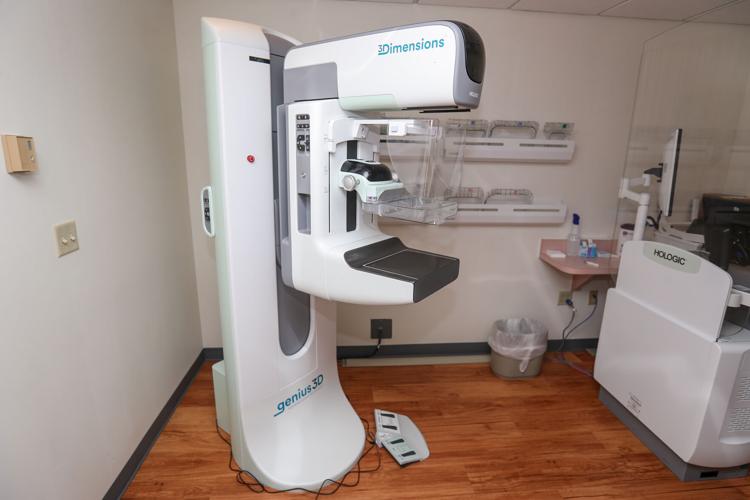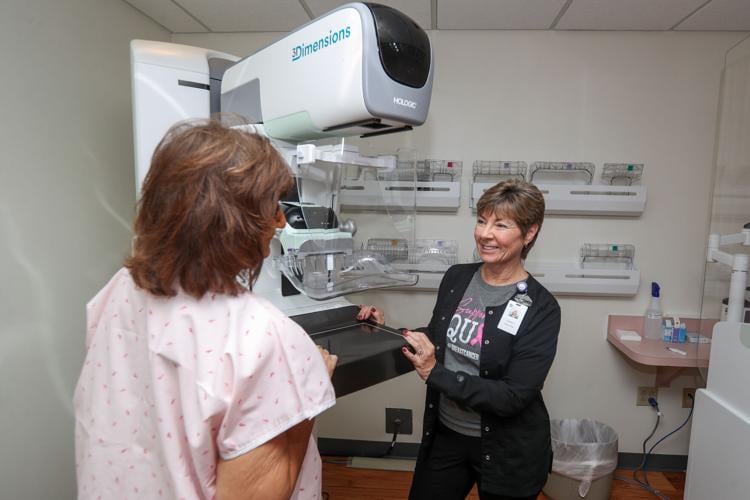HUNTINGTON �����Ƶ� Artificial Intelligence (AI) is being used in Marshall Health Network hospitals to read mammograms. It�����Ƶ�s .
Dr. Ben Moosavi, the medical director of St. Mary�����Ƶ�s Breast Center, said he is excited about the capabilities it�����Ƶ�s bringing to medicine.
�����Ƶ�AI is a fantastic addition to using computers in AI-generated protocols to enhance our screening and help our radiologists and our team in multiple ways,�����Ƶ� Moosavi said. �����Ƶ�One, it makes our detection of cancer more accurate. Two, it reduces false positives. Three, it�����Ƶ�s more efficient and cost effective. Four, it increases access to screening in underserved areas. And five, it supports clinical decisions.�����Ƶ�
St. Mary�����Ƶ�s currently has two mammography machines from Hologic Dimensions Genius AI, both equipped with AI technology. The first machine was received by the medical center in January 2021 and a second was added in September.
St. Mary�����Ƶ�s schedules about 40 mammograms per day in total, 20 on each machine. Patients who got a mammogram at St. Mary�����Ƶ�s Medical Center in the past few years may not have known AI was being used to read their mammograms.
�����Ƶ�Traditionally, the image would be captured and then the radiologist would read it. Now, the image is captured, the radiologist uses AI to help interpret the image and there are certain things that AI picks up that maybe the radiologist wouldn�����Ƶ�t. So the combination of the radiologist and AI means we�����Ƶ�re detecting up to 20% more cancers with a combination rather than the radiologist alone,�����Ƶ� Moosavi said. �����Ƶ�So it doesn�����Ƶ�t change anything with the patient experience.�����Ƶ�
All patient images are added to an archiving system. There is no extra cost incurred by patients who are screened on the machines.
Cabell Huntington Hospital will be receiving two AI-equipped machines, as well. The Hologic-Dimensions Genius AI mammography machines will go into use once Cabell Huntington relocates its Breast Center to the hospital�����Ƶ�s new Medical Outpatient Pavilion later this year.
�����Ƶ�We�����Ƶ�re at the cutting edge of technology in detecting breast cancers as early as possible,�����Ƶ� Moosavi said. �����Ƶ�The more accurate we are in detecting breast cancers and the earlier we can find breast cancers, the better patients will do long term with their treatments for breast cancer.�����Ƶ�
The software reading the mammograms can even give a percentage of how likely a lesion is to be a risk, he explained, allowing doctors to find them earlier and be more accurate and quick with their diagnoses of cancer.
Moosavi says it will �����Ƶ�never�����Ƶ� come to a point where AI completely replaces radiologists in reading mammograms.
�����Ƶ�A computer, it can interpret an image, but it can�����Ƶ�t interpret what�����Ƶ�s going on in that image. So, in other words, you could have a spot that looks high risk but is an old scar ... the computer can�����Ƶ�t tell the difference,�����Ƶ� he said.
Scars can develop in different ways, such as from lactation or a mastitis infection. It takes a human radiologist to account for that vital context when reading a mammogram.
�����Ƶ�So it�����Ƶ�ll never replace a radiologist, It just helps a radiologist,�����Ƶ� he said.
The machines�����Ƶ� software continuously adds images to its database so it can improve detection, but Moosavi says that no matter how good it gets at reading images, it�����Ƶ�s just identifying different colored pixels.
�����Ƶ�All AI is like that, the more you feed it, the more it grows,�����Ƶ� he explained. �����Ƶ�But when you look at what the technology of a mammogram is, it�����Ƶ�s a static image that�����Ƶ�s gained, it can�����Ƶ�t feed enough information once it gets to a certain point other than this is a white pixel and this is a black pixel and a gray pixel.�����Ƶ�
Teresa Clark, 73, is a breast cancer survivor who has been cancer-free for 10 years. She was getting a mammogram at St. Mary�����Ƶ�s Breast Center in September.
�����Ƶ�We (Huntington) used to really be behind because you couldn�����Ƶ�t get an MRI here �����Ƶ� not for a long time,�����Ƶ� Clark said.
She said it�����Ƶ�s a good thing medical technology is improving in Huntington. The doctors here �����Ƶ�know what they are doing�����Ƶ� and they listen, she added.
While AI reading mammograms is a good thing, Clark said she doesn�����Ƶ�t necessarily feel safer living in a world with AI, and she has concerns with some of the ways it can be used, such as to generate fake images.
�����Ƶ�AI is not good for everything. It�����Ƶ�s doing something good here because it�����Ƶ�s focused on this,�����Ƶ� she said.












